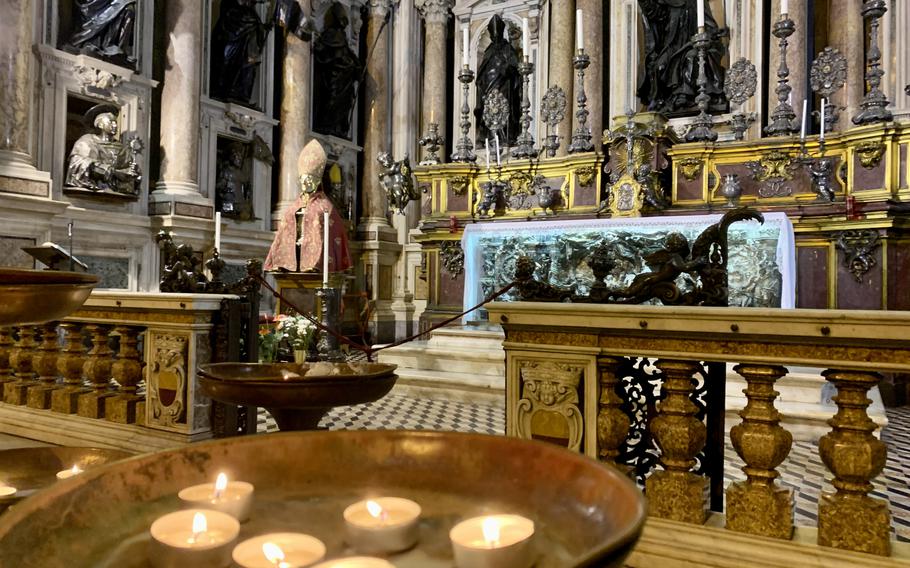
The reliquary bust of San Gennaro, the patron saint of Naples, on the altar of the chapel holds the skull bones of the saint. Several of his relics, including vials of blood, are safeguarded at the Italian city's cathedral. (Alison Bath/Stars and Stripes)
Three times a year, Naples citizens gather in anticipation of witnessing the city’s patron saint, San Gennaro, perform a miracle.
Hundreds gather outside the Cathedral of Santa Maria Assunta in the city’s historic district to see if the martyr will liquefy his dried blood, a relic kept since his beheading in 305. If the blood runs, the city is blessed. If it doesn’t, catastrophe looms.
Amazingly, the hoped-for result occurs with few exceptions. You can learn about the ritual, the history of the saint and his connection to Naples at the Museum of the Treasure of San Gennaro.

The Chapel of the Treasure of San Gennaro is dedicated to the patron saint of Naples, Italy. It is the site where a ritual is performed three times a year involving a vial of the saint's dried blood. If the blood liquefies, Naples will be blessed, it is believed. Bad fortune is portended for the city if the blood doesn't liquefy. (Alison Bath/Stars and Stripes)
Adjacent to the cathedral, the museum holds the Treasure of San Gennaro, a trove of relics and religious items made from bronze, silver and gold and decorated with diamonds, emeralds, rubies and other jewels.
You also can visit the Chapel of the Treasure of San Gennaro, where the ritual takes place, and view its Baroque architecture, frescoes and other artwork created by 17th-century craftsmen from Naples and throughout Italy.
San Gennaro, known in English as St. Januarius, is thought to protect Naples from fires, earthquakes, droughts, plagues, volcanic eruptions and other disasters. In addition, he is said to bestow help, healing and special favors.

Religious objects including chalices and jewelry are displayed along with sculptures and paintings at the Museum of the Treasure of San Gennaro in Naples, Italy. (Alison Bath/Stars and Stripes)
In return, Neapolitans venerate the saint, who refused to renounce his faith and was tortured and executed on order of the Roman emperor Diocletian during the last persecution, according to the museum.
Visitors enter the museum to the right of the ticket office and head into the chapel, which was completed in 1646.
The altar includes a reliquary bust of San Gennaro that holds the bones of the saint’s skull, the audio guide states. The rest of his relics, including vials of blood gathered by an old woman after his death, are kept at the cathedral.
Of special note is the dome, which like those of Florence and St. Peter’s Basilica in Rome, has a double shell.

Some of the frescoes adorning the dome of the Chapel of the Treasure of San Gennaro in Naples, Italy, were painted by renowned Bologna artist Domenico Zampieri, who died unexpectedly before completing the work. The dome was finished by another artist, whose fresco depicts paradise. (Alison Bath/Stars and Stripes)
Its under arches were frescoed by renowned Bologna artist Domenico Zampieri, who also completed frescoes on the main altar and five of six paintings on copper that decorate the side altars.
He died unexpectedly before finishing his work, and the dome was completed by another artist whose fresco depicts paradise.
Backtracking through the chapel takes visitors to a flight of stairs leading down to the museum’s display of paintings, sculpture and religious items dedicated to San Gennaro.

The treasure of San Gennaro includes this miter with thousands of diamonds, emeralds and rubies. Weighing nearly 40 pounds, the miter decorates the head of the bust of San Gennaro during processions. (Alison Bath/Stars and Stripes)
Among the stunning pieces is a miter, a headdress worn by bishops, decorated with 3,026 diamonds, 198 emeralds and 168 rubies and weighing nearly 40 pounds.
Designed by Neapolitan goldsmith Matteo Treglia in 1713, it is used to decorate the head of San Gennaro’s bust. The website Religion Unplugged estimates its worth at $7 million.
There’s also a jeweled collar for the bust that features diamonds, emeralds, rubies and sapphires, many of which were donated by kings, queens, popes and others over the centuries.

This necklace on display in the Museum of the Treasure of San Gennaro features diamonds, emeralds, rubies and sapphires donated by kings, queens, popes, the nobility and others in Europe over the centuries. It is used to adorn a bust of San Gennaro during processions. (Alison Bath/Stars and Stripes)
Several chalices and other religious items also are displayed, a small portion of the heavily guarded treasure.
Visiting the chapel and museum offers not only a better understanding of Naples’ love for San Gennaro but also preparation for taking in the fervor and spectacle of upcoming miracles.
The next celebration is scheduled for Dec. 16, the anniversary of the day he is credited with saving Naples from an eruption of Mount Vesuvius in 1631.

The Museum of the Treasure of San Gennaro is adjacent to the Naples Cathedral in the Italian city's historic district. The museum and chapel house his relics and an extensive collection of paintings, sculptures and bejeweled religious pieces that rival those of many of Europe's royal families. (Alison Bath/Stars and Stripes)
Museum of the Treasure of San Gennaro
Address: Via Duomo 149, Naples, Italy (closest metro stop is Piazza Cavour)
Cost: 12 euros (includes an audio guide); 8.50 euros for seniors 65 and older; free for children under 12. There also are reduced prices for families and groups, such as schools, and an option to include the Filangieri Museum for an additional 3 euros. Guided tours are offered for 20 euros.
Hours: 9:30 a.m.-6 p.m. daily for the museum treasures; for the chapel, 9:30 a.m.-1 p.m. and 3-6 p.m. Monday and Saturday; 9:30 a.m.-1 p.m. and 2:30-6 p.m., Tuesday-Friday; and 9 a.m.-1 p.m. and 4:30-6 p.m. Sunday .
Information: Phone: +39 081-294980; online: tesorosangennaro.it/en/home-en